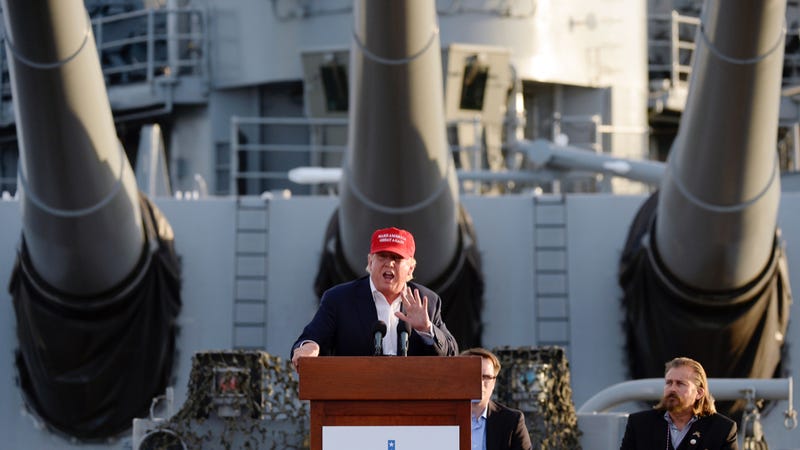It’s been announced that President Trump will seek to increase military spending by $54 billion, taking this money out of the budgets of other federal departments (the specific programs these departments would cut has not yet been decided). This is a significant amount of money–it’s enough to build the Trump wall twice over, and it’s nearly three times the size of the NASA budget. It’s nearly enough to pay for tuition-free college, which costs $70 billion. The cuts are still in the proposal stage–congress must pass a budget which incorporates these changes before they would become law. Nevertheless, it’s worth taking a moment to emphasize just how unnecessary and wasteful this is.

The Budget Control Act capped military spending at $549 billion for 2018, which is 7.8 times the cost of tuition-free college. We could fit nearly 30 NASAs into that budget or use it to build almost two dozen Trump walls. Trump’s proposed increase would bring military spending to $603 billion. But lest anyone imagine that Trump is the most hawkish politician on the scene, we should bear in mind that US Senator John McCain (R-AZ) thinks this isn’t enough–he wants the US to go to $640 billion. How would these proposals change the balance of spending between the United States and its leading geopolitical rivals?
It’s hard to be sure, because it’s difficult to know how efficiently different countries are consuming their military budgets (indeed, it’s hard to be sure how efficiently our own country is consuming its budget). But we can make direct comparisons in terms of total spending. We can add US military spending to China’s and Russia’s and then divide US spending by that total to get a feel for the level of resource commitment we’re laying out relative to the biggest players on the world stage.
We’ll start by comparing the Budget Control Act baseline budget to the most current figures SIPRI has for China and Russia:
Even under the baseline budget, the US already spends 2/3rds of this total. How much stronger does Trump’s plan make us? Let’s put his figures in:
Wow! Look at Donald Trump, increasing that US share by a historic 2 points. I feel so much safer already–don’t you? What if we went with the McCain plan? Let’s try it out:
McCain doubles the difference, increasing the spread by another measly 2 points. How does this compare historically? SIPRI goes back to 1988. Here’s how strong we were in the last year of Ronald Reagan’s presidency:
Even under the baseline budget we can expect to be stronger relative to Russia and China than we were in 1988. But wait! I’ve been using SIPRI‘s most recent data for China and Russia–what if China and Russia spend more in 2018? To tighten my argument, I’ve decided to project changes in the Russian and Chinese budgets based on their recent trajectories. In the Chinese case, I assumed a 7.5% annual increase in spending. In the Russian case, I assumed an 8.3% increase. Even with these assumptions, the Budget Control Act baseline looks more or less exactly like any old Reagan year:
What if instead of increasing the military budget, Trump decided to do something zany and left wing? What if he took $54 billion from the other government departments, but decided to spend that money on tuition-free college, and then got the remaining $16 billion he needed from defense? What would that do?
The answer is almost nothing. What if Trump decided to leave the other departments alone and got the entire $70 billion from defense?
Even that looks pretty harmless, doesn’t it? And remember, all three of these countries have nuclear deterrents, so the raw balance of conventional forces is not as important as it would have been in 1942. Because of nuclear weapons, none of these countries can realistically invade one another without risking a cataclysm that none of them want, and because of the Atlantic and Pacific Oceans an invasion of the United States is a logistical nightmare in any case. So what is this money for? What precisely do we need to do militarily that we otherwise would not be able to afford?
Military spending increases are never justified in terms of what the money is specifically supposed to do. Instead, we are given vague arguments about how we need to be “strong”, or worse, seemingly detailed arguments about the various kinds of new hardware we need to buy without any grand strategy rationale for why we need that hardware. Carly Fiorina loved to do this–she’d make long lists of hardware we “need” without ever telling us what on earth it’s meant to do for us.
Military spending has an opportunity cost–if we spend on the military, that’s money we can’t spend on education, healthcare, or even rudimentary things like the State Department. It’s not enough for the numbers to sound large and make us feel safe. We need a real international relations argument for why this additional spending is necessary. No one has offered that argument. We’re hearing lots of assertions about how President Obama “neglected” the military, but Obama left our military stronger than it was under Reagan:
The arguments being made by Trump, McCain, and other Republicans do not reflect the facts. The US military is in great shape. If anything, there’s fat to cut. The public debate is not grounded in reason. Republicans believe that we’ll feel more secure if they throw large numbers at us and list vast quantities of hardware they have no plan to use and which do not substantively increase the size of our deterrent. Their rhetoric presupposes our ignorance of the basic geopolitical situation and is an insult to our intelligence.







